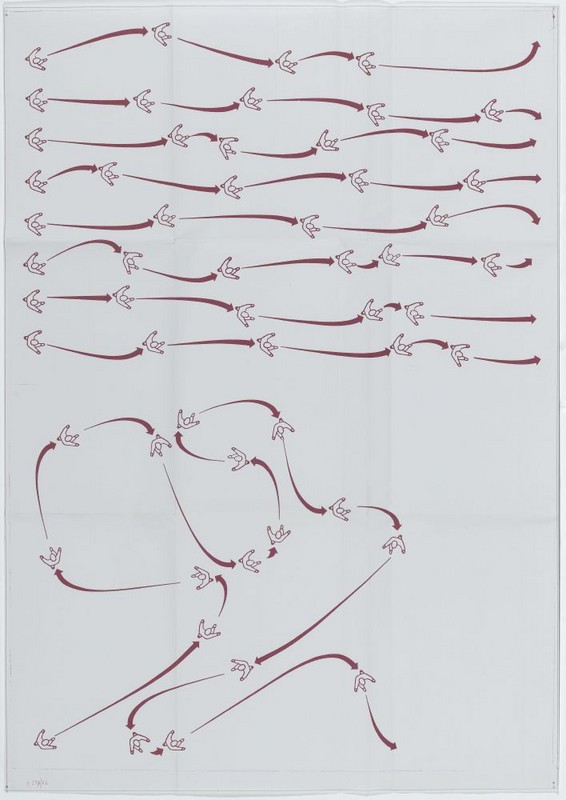Lines: a Brief History
11 Jan - 01 Apr 2013

Léon Ferrari
Caminos
Centre Pompidou, Musée national d’art moderne, Paris
© Léon Ferrari
© Centre Pompidou, MNAM-CCI, Dist. RMN-Grand Palais / Philippe Migeat
Caminos
Centre Pompidou, Musée national d’art moderne, Paris
© Léon Ferrari
© Centre Pompidou, MNAM-CCI, Dist. RMN-Grand Palais / Philippe Migeat
LINES: A BRIEF HISTORY
Curators:
Hélène Guenin, Head of Programming, Centre Pompidou-Metz.
Christian Briend, Curator, Centre Pompidou, Musée National d’Art Moderne, Drawings Department.
11 January - 1 April 2013
Building on a central body of works conserved by the Drawings Department at Centre Pompidou, Musée National d’Art Moderne, Lines: a Brief History takes an original look at the practice of drawing, and lines in general, from 1925 to the present. It is based on the eponymous book by the social anthropologist Tim Ingold(1), who works from the premise that "to study both people and things is to study the lines they are made of".
His Comparative Anthropology of the Line studies the presence and production of lines in everyday human activity, across the continents and in different cultures. Walking, writing, weaving all belong to this "production of lines". Lines are part of our environment and measure our acts and movements. Threads, traces, cuts, cracks or creases, permanent or ephemeral, physical or metaphorical, lines are everywhere. Every gesture, every movement is a dynamic and temporal line; an invisible language.
The exhibition continues this exploration and looks at the drawn or imagined line, extending the definition of drawing to the space around the body and the landscape. The 220 works shown over 1,200 sq m in Galerie 1 consider the line as movement and trajectory, and the world as a mesh or network of lines, to suggest a certain spiritual, magical or poetic connection between the line and the world. Some 80 artists are represented, from Vasily Kandinsky to Dove Allouche, with works by Marcel Duchamp, John Cage, Vera Molnar, Giuseppe Penone, and many others.
(1) "Lines: a brief history", Tim Ingold, 2007, Routledge: London. ISBN 978-0-415-42427-1
Curators:
Hélène Guenin, Head of Programming, Centre Pompidou-Metz.
Christian Briend, Curator, Centre Pompidou, Musée National d’Art Moderne, Drawings Department.
11 January - 1 April 2013
Building on a central body of works conserved by the Drawings Department at Centre Pompidou, Musée National d’Art Moderne, Lines: a Brief History takes an original look at the practice of drawing, and lines in general, from 1925 to the present. It is based on the eponymous book by the social anthropologist Tim Ingold(1), who works from the premise that "to study both people and things is to study the lines they are made of".
His Comparative Anthropology of the Line studies the presence and production of lines in everyday human activity, across the continents and in different cultures. Walking, writing, weaving all belong to this "production of lines". Lines are part of our environment and measure our acts and movements. Threads, traces, cuts, cracks or creases, permanent or ephemeral, physical or metaphorical, lines are everywhere. Every gesture, every movement is a dynamic and temporal line; an invisible language.
The exhibition continues this exploration and looks at the drawn or imagined line, extending the definition of drawing to the space around the body and the landscape. The 220 works shown over 1,200 sq m in Galerie 1 consider the line as movement and trajectory, and the world as a mesh or network of lines, to suggest a certain spiritual, magical or poetic connection between the line and the world. Some 80 artists are represented, from Vasily Kandinsky to Dove Allouche, with works by Marcel Duchamp, John Cage, Vera Molnar, Giuseppe Penone, and many others.
(1) "Lines: a brief history", Tim Ingold, 2007, Routledge: London. ISBN 978-0-415-42427-1
